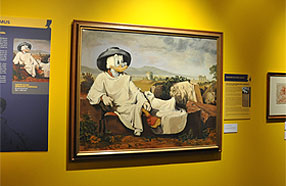On October 29, 1786, Goethe arrived in Rome, where he was met by the painter Johann Heinrich Wilhelm Tischbein. The rest, as they say, is history: the two traveled Italy together, and their long friendship would be commemorated in Tischbein’s most famous painting, the most famous image of Goethe ever produced.

A century and a half later, Roger Tory Peterson posed for a portrait of his own — striking a pose that I have always suspected was modeled on Goethe’s.

Whether that connection is real or — just barely possibly conceivably — imagined, there is another, more easily demonstrated. For Tischbein, the creator of so many famous portraits and classicizing history paintings, was a lapsed birder.
From Rome, the artist wrote to Johann Heinrich Merck
I was once a great amateur of birds and knew almost all the species, especially the native ones. In Holland I saw some very fine ones. I like birds very much; it seems to me that they occupy the same place in living nature as flowers in a nature morte. The bright, beautiful colors and the feathers in themselves are a beautiful thing. I’ve seen some here I didn’t know before: a green bird that resembles a kingfisher but is a type of thrush; a blue thrush; and another little birdlet like a wren.
Tischbein, who had etched some of the early plates for the Nozeman – Sepp Nederlandsche vogelen, even considered producing an illustrated guide to the birds of Rome:
If I could be certain that these birds were not already known, I would have them drawn and their life histories added.
It didn’t happen. And maybe that’s just as well.


